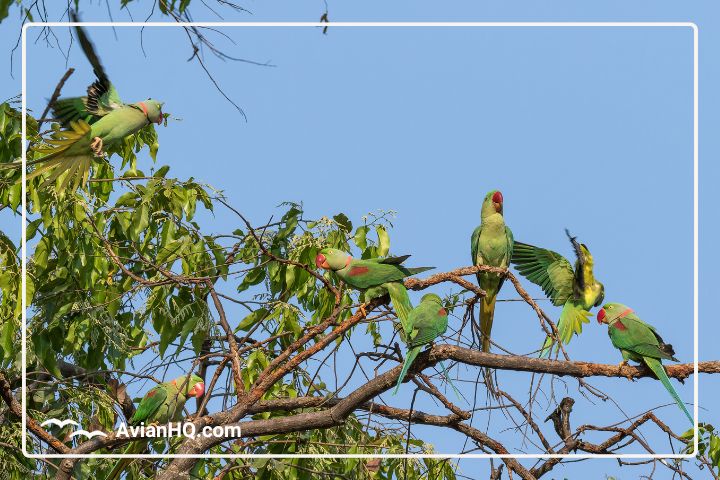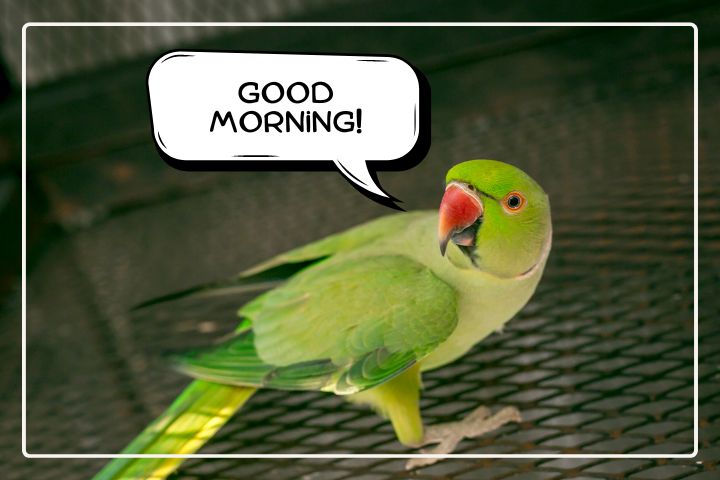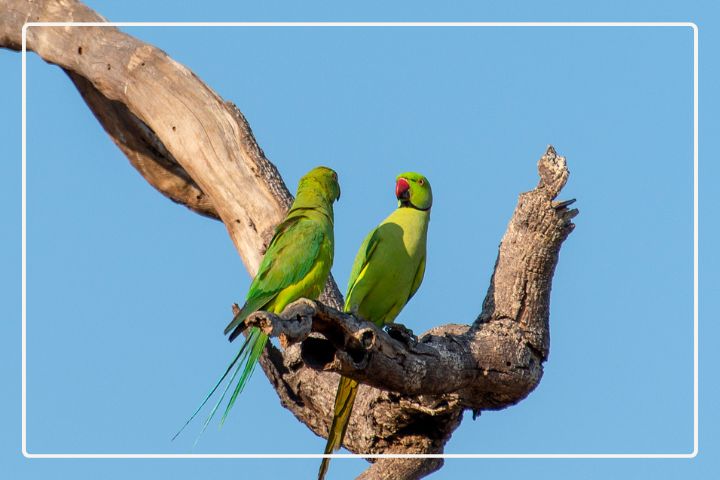Echo Parakeet: Overview, Characteristics and Care
As passionate bird enthusiasts, we are thrilled to introduce you to the Echo Parakeet (Psittacula eques) aka the mauritius parakeet. It is a fascinating bird species native to the island of Mauritius in the Indian Ocean. These beautiful birds are known for their stunning plumage, charming personalities, and distinct vocalizations.
We’ll provide you with a comprehensive overview of the Echo Parakeet, covering everything from their physical appearance, behavior, diet, and habitat, to essential care tips for keeping them as pets.
Key Takeaways:
- Echo Parakeets are a unique species of bird native to Mauritius in the Indian Ocean.
- These birds are known for their striking plumage, charming personalities, and distinct vocalizations.
- We’ll cover everything you need to know about Echo Parakeets, including their physical appearance, behavior, diet, habitat, and care requirements.
Physical Appearance of the Echo Parakeet
The Echo Parakeet, also known as Psittacula eques, is a stunning bird with striking physical characteristics. These birds are on the larger side of the parakeet spectrum, with males growing up to 40 cm (16 in) and females slightly smaller at about 36 cm (14 in) in length. They are also relatively heavy, with males weighing around 200-230 g (7-8 oz) and females around 170-190 g (6-7 oz).
Their most distinguishing feature is their colorful plumage, which is predominantly green with hints of blue and yellow on the wings, tail, and head. The males have a black and pink ring around their necks, while females have a more subtle green/grey ring.
The male’s upper bill is red and the lower part is a dark brown color. On the other hand, the female has a completely black upper bill. Their eyes are surrounded by an orange-colored skin, while their feet are grey in color. When they are young, their bill has a reddish-orange hue, but it changes to black once they leave the nest. Likewise, immature birds resemble the female in appearance. Their beaks are relatively large and curved, allowing them to crack open seeds and nuts with ease.
They also have strong legs and feet that allow them to climb and perch with ease.
Subspecies and Geographical Variations
There are two recognized subspecies of the Echo Parakeet, the Mauritian and Réunion subspecies. The Mauritian subspecies is the most common and has a brighter plumage with more pronounced blue and yellow colors. The Réunion subspecies has a duller plumage and is smaller in size than its Mauritian counterpart.
The Echo Parakeet is endemic to the island of Mauritius in the Indian Ocean, and historically, its distribution was limited to the southwestern part of the island. However, their range has expanded thanks to successful conservation efforts, and they can now be found in other parts of the island.
Behavior and Temperament of the Echo Parakeet
At first glance, the Echo Parakeet may appear aloof or distant, but this couldn’t be further from the truth. These birds are intelligent, social, and highly communicative.
Echo Parakeets are known for their strong flock mentality and are rarely seen alone. They prefer to stay in small groups, which can consist of anywhere from two to ten individuals. These groups have a stable social structure, with a clear hierarchy where the dominant bird takes charge of the flock’s activities and movements.
Communication is a central part of the Echo Parakeet’s social behavior. They use a variety of vocalizations, including calls, whistles, and squawks, to communicate with one another. They also employ body language and physical displays to convey their mood, intentions, and social status. These behaviors are essential in maintaining the flock’s stability and cohesion.
Echo Parakeets can be quite engaging with humans, although they may take some time to become comfortable with their owners. Taming and training techniques can help build trust and create a bond with these birds. Early socialization is also crucial to ensure that Echo Parakeets remain friendly and adaptable to new situations.
Diet and Feeding Habits of the Echo Parakeet
The Echo Parakeet’s diet consists mainly of fruits, seeds, and flowers found in their natural habitat. In captivity, a balanced diet includes a variety of fruits, vegetables, and commercial seed blends, with a focus on fresh, nutrient-rich foods.
It is essential to provide fresh water every day, as the Echo Parakeet may refuse to drink water that has been stagnant for too long. Additionally, offering a cuttlebone or mineral block can help meet their calcium and other mineral needs.
The Echo Parakeet has a robust beak that is designed to crack open seeds and nuts. Therefore, it is vital to provide them with a variety of foods that require different chewing and foraging techniques to keep them stimulated and engaged.
Overfeeding and a lack of proper exercise can lead to obesity in Echo Parakeets, which can cause health problems. Therefore, it is essential to monitor their diet and adjust their food intake as necessary.
When introducing new foods to your Echo Parakeet’s diet, do so gradually to avoid digestive upset. If you notice any signs of illness or discomfort, such as lethargy, loss of appetite, or diarrhea, contact a veterinarian who specializes in avian care immediately.
Habitat and Distribution of the Echo Parakeet
The Echo Parakeet is native to the island of Mauritius in the Indian Ocean. Historically, they were found throughout the island’s forests, but their populations have drastically declined due to habitat loss and hunting.
Today, Echo Parakeets are mainly found in the Black River Gorges National Park, where conservation efforts have helped increase their numbers. However, their range is still limited, and they require specific habitat conditions to thrive.
Echo Parakeets prefer to live in humid, evergreen forests with dense vegetation and a variety of native tree species. They also require open areas for foraging and breeding, such as forest clearings or edges. Additionally, they are known to nest in cavities of dead trees, which are increasingly rare due to deforestation.
Unfortunately, the limited habitat and distribution of the Echo Parakeet make them vulnerable to extinction. Conservation efforts such as reforestation and nest box installation are essential for ensuring the survival of this species in the wild.
Breeding Behavior and Reproduction of the Echo Parakeet
The Echo Parakeet’s breeding behavior and reproduction strategies are unique and fascinating. These birds typically breed once a year and form monogamous pairs during the breeding season. However, they may also engage in extra-pair copulations within their social group.
Mating rituals involve the male displaying his colorful feathers and vocalizing to impress the female. Once a pair bond is formed, they select a suitable nesting site, typically a hollow in a tree trunk. Females lay 2-4 eggs, which both parents take turns incubating for about 22 days.
After hatching, the chicks are cared for by both parents. They are fed regurgitated food and grow quickly, fledging at around 50-60 days. However, the young birds may stay with their parents for up to a year before becoming independent.
Unfortunately, the Echo Parakeet’s breeding success is threatened by a range of factors, including habitat loss and fragmentation, predation by introduced species, and low genetic diversity due to historical population declines. Conservation efforts are critical to ensure the survival of this unique and valuable bird.
Vocalizations of the Echo Parakeet
The Echo Parakeet is a highly vocal species, known for their varied and distinctive calls and vocalizations. These birds use their vocalizations for communication with each other, as well as to establish and maintain their territory.
The calls of the Echo Parakeet are highly variable and can range from high-pitched whistles to squawks, screeches, and trills. They are also known for their ability to mimic sounds and voices, including human speech.
In the wild, Echo Parakeets are often heard before being seen. Their loud and raucous calls can be heard over long distances, allowing them to communicate with other members of their flock and avoid potential predators.
As pets, Echo Parakeets can be trained to mimic sounds and even speak simple words and phrases. However, it’s important to note that not all Echo Parakeets will develop this ability, and training should only be done with positive reinforcement techniques to avoid stressing or traumatizing the bird.
The vocalizations of the Echo Parakeet are an important aspect of their behavior and communication. By listening to these calls and learning to interpret their meaning, we can better understand and appreciate these fascinating birds.
Pet Care for the Echo Parakeet
If you are considering bringing an Echo Parakeet into your home, it is essential to understand their specific care requirements to ensure they thrive in captivity. Whether you are purchasing a young bird from a breeder or rescuing one from a shelter, here are some important tips and guidelines for pet care:
Taming and Training
When you first bring your Echo Parakeet home, it is essential to give them time to adjust to their new surroundings. Let them settle in for a few days before attempting to handle or interact with them. Once they seem comfortable, begin the taming process by offering them treats from your hand and gradually working up to more extended periods of handling and playtime.
Training your Echo Parakeet to step onto your hand or other objects can be a useful tool for bonding and making them comfortable with handling. Use positive reinforcement techniques such as offering treats or praise to encourage desired behaviors.
Cage Setup
The size and layout of your Echo Parakeet’s cage are crucial factors in their overall health and happiness. Ideally, their enclosure should be large enough to allow for plenty of movement and exercise, with multiple perches and toys to keep them entertained. Make sure to include a variety of feeding and drinking stations to encourage natural behaviors.
It is also essential to keep their cage clean and sanitized regularly, as Echo Parakeets are susceptible to respiratory infections. Use a mild soap and warm water to clean the cage and accessories, and avoid using harsh chemicals or bleach.
Socialization and Enrichment
As social birds, Echo Parakeets thrive on interaction with their owners and other birds. Consider getting them a same-sex companion bird if you are unable to provide them with enough socialization on your own.
Providing your Echo Parakeet with plenty of toys, including puzzles and interactive feeders, can help keep them mentally stimulated and prevent boredom-related behaviors such as feather plucking or aggression.
Health Issues and Care for Echo Parakeets
As with any pet, Echo Parakeets may experience health issues due to a variety of factors. It’s essential to keep a close eye on your bird’s behavior and physical condition to ensure they stay healthy and happy. Here are some common health issues to watch for:
| Health Issue | Symptoms | Treatment |
|---|---|---|
| Feather Plucking | Bald patches, excessive preening, and feather destruction | Identify and address underlying causes, such as boredom or stress. Provide toys and environmental enrichment. |
| Respiratory Infections | Coughing, sneezing, wheezing, and difficulty breathing | See an avian veterinarian for diagnosis and treatment with antibiotics or other medications. |
| Beak and Feather Disease | Beak deformities, abnormal feather growth, and susceptibility to infections | No cure exists, but avoiding exposure to other infected birds and a nutritious diet can help manage symptoms. |
If you notice any of these symptoms or other unusual behavior in your Echo Parakeet, it’s best to consult with an avian veterinarian immediately. Regular check-ups with a veterinarian can also help prevent many health issues by catching them early and providing preventative care.
Caring for an Echo Parakeet also involves providing a healthy and stimulating environment to promote their well-being. It’s essential to maintain a clean and spacious cage, provide fresh food and water daily, and offer plenty of toys and activities to keep them occupied. Avoid using products containing chemicals or toxins that may harm your bird.
Finally, it’s essential to maintain a regular schedule for your Echo Parakeet to promote their daily rhythms and sleep patterns. Providing a consistent environment with designated periods for play, rest, and sleep can help reduce stress and promote their overall health and happiness.
Daily Rhythms and Lifespan of the Echo Parakeet
Understanding the daily rhythms and natural behaviors of the Echo Parakeet is essential for providing optimal care in captivity. These birds are diurnal, meaning they are most active during the day and require a peaceful, dark environment to rest at night.
In the wild, Echo Parakeets exhibit a range of natural behaviors, including foraging for food, socializing with other birds, and engaging in courtship rituals during breeding season. They are also known to take frequent baths to keep their feathers clean and healthy.
A healthy Echo Parakeet can live for up to 20 years or more in captivity with proper care. However, their lifespan in the wild is significantly shorter, with many individuals succumbing to predation, habitat loss, and disease.
It is important to note that the lifespan of Echo Parakeets can vary depending on several factors, including genetics, diet, environment, and access to veterinary care. As such, providing a balanced diet, ample space for exercise, and prompt medical attention when necessary can help ensure a long, healthy life for your pet Echo Parakeet.
Conservation Status and Challenges
The Echo Parakeet is classified as “Endangered” on the International Union for Conservation of Nature (IUCN) Red List. Once considered one of the rarest parrots in the world, the Echo Parakeet has made a remarkable recovery in recent years, thanks to extensive conservation efforts. However, they still face significant challenges that threaten their survival.
One of the main challenges facing the Echo Parakeet is habitat loss. The forests where they live are being destroyed at an alarming rate due to human activity, such as deforestation and land-use changes. This destruction of habitat also affects other species that coexist with the Echo Parakeet, causing a domino effect on the ecosystem. Another significant threat is the illegal pet trade, which has long plagued the parrot family.
Despite being protected by law, the demand for the Echo Parakeet remains high, making them an attractive target for poachers. Many of these birds are taken from the wild as chicks, separating them from their parents and compromising their development.
Disease outbreaks have also been a major concern for the Echo Parakeet population. Avian malaria is a deadly disease that can be transmitted to parrots by mosquitoes. This disease can spread rapidly in captive populations and can have catastrophic consequences for wild populations.
The conservation of the Echo Parakeet is a collaborative effort between conservation organizations, government agencies, and local communities. Strategies such as habitat protection, captive breeding, and reintroduction programs have been successful in increasing the population of the Echo Parakeet.
Although significant progress has been made in protecting this species, there is still much work to be done. The challenges facing the Echo Parakeet require continued commitment and a multi-faceted approach to conservation. By working together, we can ensure the survival of this incredible bird for generations to come.
FAQ
What is the physical appearance of the Echo Parakeet?
The Echo Parakeet is a medium-sized parrot with bright green plumage, a red beak, and a distinctive blue patch on its wings.
How does the Echo Parakeet behave and what is its temperament?
Echo Parakeets are social birds that live in flocks. They are known for their playful and curious nature, but can also be territorial and vocal.
What do Echo Parakeets eat and what are their feeding habits?
Echo Parakeets primarily eat fruits, seeds, and flowers. In captivity, they can be fed a diet consisting of high-quality pellets, fresh fruits, and vegetables.
Where do Echo Parakeets live and what is their distribution?
Echo Parakeets are endemic to the island of Mauritius in the Indian Ocean. They are primarily found in forests and wooded areas.
How do Echo Parakeets breed and reproduce?
Although certain Echo Parakeets establish monogamous pairings during the reproductive period, others display a proclivity for polyandry. The female lays eggs in tree cavities, and both parents take turns incubating them.
What sounds do Echo Parakeets make?
Echo Parakeets have a range of vocalizations, including calls, squawks, and whistles. They use these sounds to communicate with each other and establish territory.
How can I care for an Echo Parakeet as a pet?
To care for an Echo Parakeet as a pet, provide a spacious cage, a balanced diet, regular socialization, and mental stimulation through toys and activities.
What health issues do Echo Parakeets face and how can I care for their health?
Echo Parakeets can be prone to respiratory infections and vitamin deficiencies. Regular veterinary check-ups, a healthy diet, and a clean living environment are essential for their well-being.
What are the daily rhythms and lifespan of Echo Parakeets?
Echo Parakeets are diurnal creatures with a lifespan of up to 20 years in the wild and longer in captivity. They are most active during the day and require regular sleep at night.
What is the conservation status of Echo Parakeets and what challenges do they face?
Echo Parakeets are listed as critically endangered due to habitat loss and predation. Conservation efforts focus on protecting their natural habitat and implementing breeding programs.








Hey very cool website!! Man .. Excellent .. Amazing .. I’ll bookmark your blog and take the feeds also…I’m happy to find numerous useful information here in the post, we need develop more strategies in this regard, thanks for sharing. . . . . .